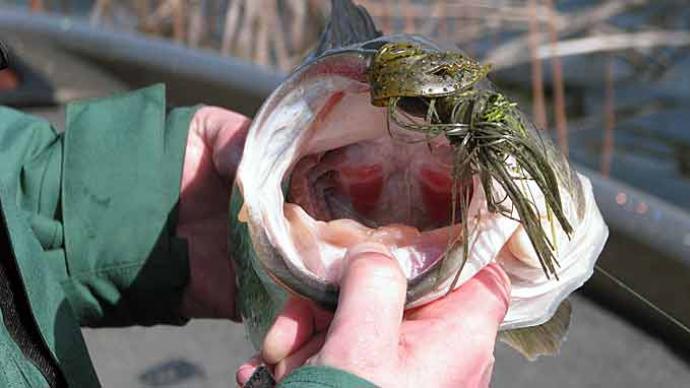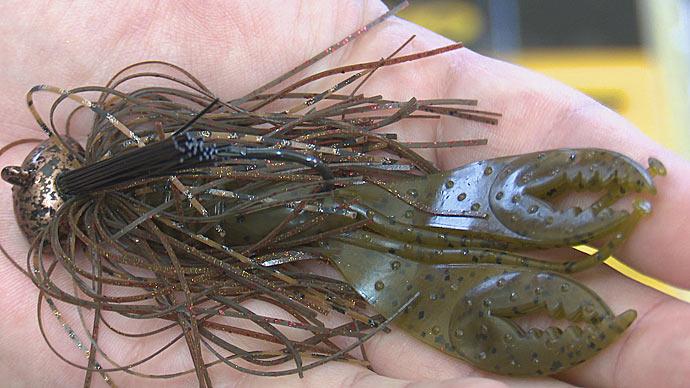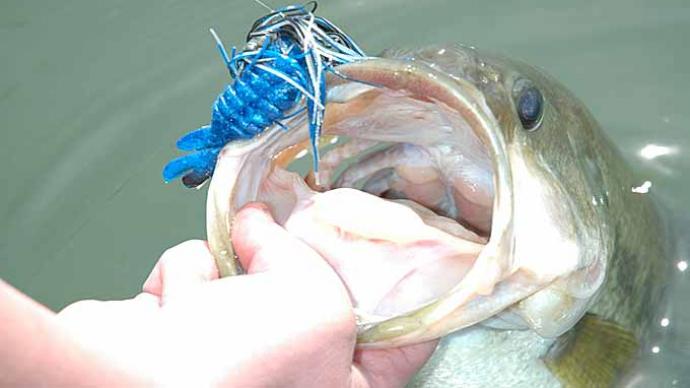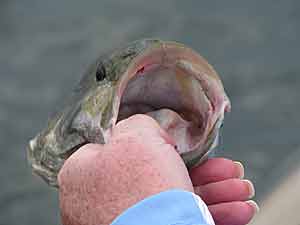
It's no secret that one of my all-time confidence baits is a jig-n-pig. I can think of no other bait that catches big fish as consistently. Before you think Senko, remember that jigs have been catching bass for over 40 years, and the Senko is still a rookie. For some reason, bass love to snack on these skirted wonders.
I cut my teeth fishing jigs early in my bass fishing exploits to phase them out as I downsized my tackle. I rediscovered them in the mid-nineties and built a bait company based on my micro-sized jig-n-pigs. I have customers in every state East of the Mississippi and many more out West.
Most of my fishing is based on a four-rod rotation of baits that includes a light version of the jig-n-pig on at least one. This light 1/8-ounce or 1/16-ounce jig has been so successful for me that it is hard to put it down. It was the reason I put the Senkos aside when they hit the market. I just stuck with what was working for me. I had spent so much time with the smaller lighter jigs that I don't remember when I last fished a 1/4-ounce jig with any consistency. Confidence is not a factor here. It was just that I became so in tune with the smaller jigs that I neglected the larger ones. Another factor was that 99% of guys who jig fish are fishing larger jigs. My finesse approach allowed me to come in behind them and catch fish they missed with an angle fish they were not used to seeing.

The success of my small business is based on my light tackle jigs. I never actually wanted to build a larger jig because I didn't need to fish one. I was prompted by several big-name guys, who experimented with my small jigs, to build them a big one. I started in late 2000 by looking for something different. It didn't take me long to come up with the grass jig. I quizzed anglers about their likes and dislikes about the jigs they fished. All wanted a bait that would come through the weeds easier than their current baits. I thought about incorporating a triangular head with a weed guard in line with the head to make it more streamlined. I added a sharp hook that also was a bit recessed to stay out of the way yet be solid upon hooking up. The hook I chose at the time was a Mustad black nickel needlepoint. This was at a time when I predicted that the industry would make this the hook of choice over even the Gamakatsu. The hook was a solid performer, and the industry started to use them on most jigs up to the present. The mega bite hook is a kind of Kahle-looking hook with incredible holding power. I sifted through all of the different hooks by the different manufacturers and couldn't agree that there was a better hook out there.
My next decision was to keep doing what made my other baits successful. My larger jigs would get the Pro-Tec Powder paint job, the soft fiber guard, and a top-quality HydroSilk skirt. The difference would be that I chose to cure the painted heads in an oven to make them have the hardest finishes around. They are virtually chip-proof. HydroSilk silicone is different from regular silicone that all other manufacturers use. It is more round silicone and is best compared to StarFlash rubber. The only differences are 1-It floats in the water, which gives it a dynamite action, 2- It will not go up like rubber. And 3- It does not contain the massive amounts of glitter that StarFlash does. The skirts are 66 strand skirts meaning they have 132 tips pulsating in the water. That is a bulky jig, but the extra body does not prevent successful hooksets.
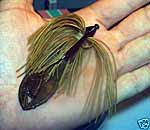
I have since updated my Grass Jig series to stand-up heads. Once they find the bottom, these heads lurch forward, so the hook rides up. This is like what a crawfish in the defensive position looks like. The floating HydroSilk skirt still does a good job covering the hook. I've kept the paint the same but decided to switch the hook up in favor of a new Gamakatsu black nickel hook. I wanted to go with a round bend model for the stand-up head, and so far, I've heard great things about it, and I've had great experiences with it.
Heavy-duty Jig Fishing
Before I get into this, let's understand that I consider any jig 1/4-ounce or larger heavy. Catch 10,000 bass or so on a 1/16-ounce or 1/8-ounce jig, and you would like also.
When fishing heavy jigs, I abandon the realm of spinning tackle and move up to stout baitcasting gear. This is necessary to transport your offering to nasty places and to get it back. I usually do not skip with a baitcasting rod. It can be done, but you must have an extremely educated thumb to prevent backlashes.
I use Shimano reels exclusively. Contrary to many other anglers, I do not use a hefty line. A 10 or 12-pound line fills the bill for me and can handle most situations. I like Hybrid or X-Tex lines. Gamakatsu G-Lock is also very good for flipping. I have used Vanish, and I like it also. It has excellent abrasion resistance. I only tie my jigs on with a Palomar knot. I feel this is the strongest, most reliable knot anyone can tie. I rely on BPS Extreme rods in 6-6 to 7 ft lengths. I prefer a medium-action rod. I've been flipping with a 6-foot medium-light action rod and Shimano reel this season. I usually do not go above a 3/16-ounce jig, but it is a dynamite combo. I've never broken a BPS rod while fishing. I know some guys will swear by Loomis...go ahead. It is like buying French wine.....I get by just fine with California wine!
Targeting Bass
I can flip, I can skip, I can pitch. Which is best? Do what works for you. I am more effective in skipping with a spinning rod, so I usually do not skip with baitcasting rods. I do a cross between flipping and pitching. It is a kind of underhand lob low to the water that may be skipping-like in reality. When the bait hits the water, there is very little disturbance.
I am always searching for targets to hit. I will drop jigs into places many guys won't. You can't worry about losing a bait. If you do, you will handicap yourself mentally. Putting jigs in challenging places can mean the difference between catching a horse or casting practice. I hit my targets from many different angles. This gives the fish a presentation it may not have seen. I see many guys drop a jig on a stump once or twice only to move on. I do not fish my jig back to the boat. Once I feel I have saturated the target, I reel in and cast again.
Strikes range from a mushy weighty feeling to an unmistakable chomp. I learned to fish jigs by forcing myself to only take them with me while fishing. I learned to discern what the jig felt like at the end of my line. Anything lighter or heavier was indeed a bass. This is what I have come to name "weighing the line." This strategy has helped me learn complex techniques and has made me a better, more consistent angler.
Let's talk about hooksets. If you are fishing a jig correctly, you will have a tiny slackline. This makes for quick hooksets and excellent sensitivity. If you feel something out of the ordinary, swing on it, hooksets are free. I set my hook hard over my right shoulder. It is violent, lightning-quick, and gets the job done. I notice that very few anglers get the gist of the hookset in most applications. There is no pussy footing around here. Set it as you mean it, or go home empty-handed. There is no style to it, just speed and power. Detecting a strike will come as a natural feeling in time and with practice. The time it takes you to detect a strike and swing on it is the difference between hooking up and getting beaned in the head by your jig. A jig is made of metal and silicone. A bass will rarely hold on to it for an extended period. Scent and salt may help increase the odds by a half-second, but it is essential to set up as soon as you detect the strike.
Rattles
Rattles may give the angler an advantage when the water is murky or cold. I prefer to fish with out rattles 95% of the time. When I use them, I prefer the strap type of collar, so the rattles hang down in the skirt. This way, they do not impede with my hookset. I employ one little trick to add a small piece of sponge on the hook shank. I spray it with a bit of garlic or a craw scent. I think it at least gives me the confidence to be more effective.
A jig is a contact bait. It is built to be used in nasty places, and it is strong enough to wrestle big bass out of them. Many guys make the mistake of not attempting to penetrate deep into cover with them. By failing to do this, they decrease their chances for success.
Although I am a light tackle jig guy by nature, I'm smart enough to realize that heavy jigs have a place in my arsenal. On the other side of it, don't just use heavier baits. You will be pleasantly surprised when you tie on a light jig-n-pig.


